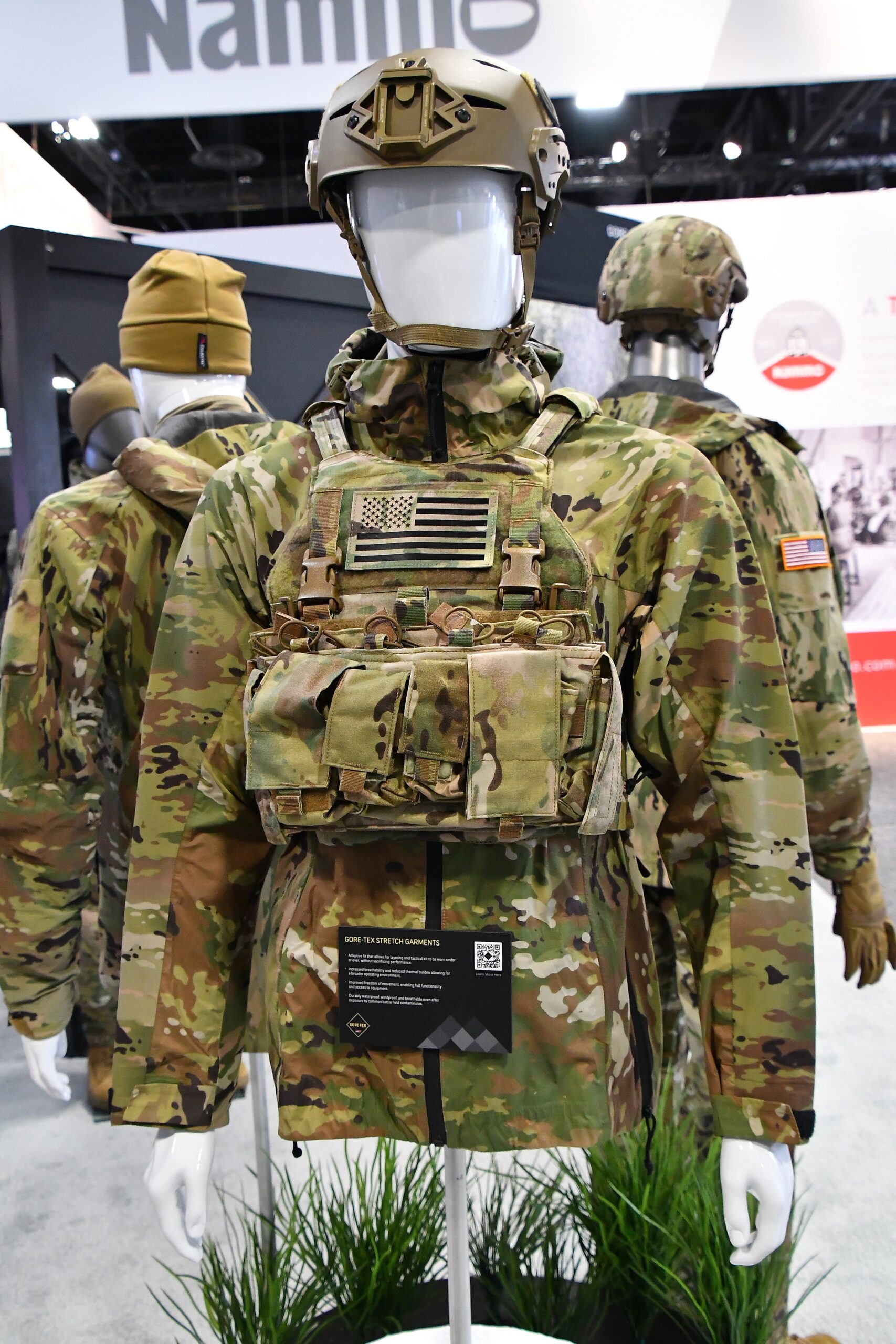
During last week’s AUSA event GORE-TEX brand outfitted three mannequins with jackets made from their GORE-TEX Stretch Fabric Technology which retains the water and wind proof breathable characteristics of Gore’s ePTFe material but adds the ability to stretch.
This offers an adaptive fit that reduces air gaps and leads to a more optimized design with less bulk. This means a garment with a more tailored fit can be worn with underlayers without going up a size. It will also move with the wearer. An added bonus is that the fabric improves the garment’s evaporative resistance and increases breathability by 25%.

It was an excellent means to demonstrate how verstaile a shell garment made from the GORE-TEX Stretch fabric is. It can be worn under armor, or over it, fully protecting the gear from
invelement weather.



An added bonus is that the fabric improves the garment’s evaporative resistance and increases breathability by 25%. What is the rating?
Since it stretches does that mean it is more like a soft shell and crinkly shells will be a thing of the past?
“the fabric improves the garment’s evaporative resistance and increases breathability by 25%”
So what does that mean? User will be slightly less cold and slightly less clammy?
Robert Gore’s claim that you will “warm and dry” with Gore-Tex is one of the greatest frauds ever.
I’m genuinely curious as to how you think so? Spent plenty of nasty wet, snowy nights out and about with a goretex shell and microfleece or polypro underlayer without being cold or clammy. We’ve come a long way from Gen 1 ECWCS.
If you’re layering properly and not waiting until you’re already soaked through to put it on, there shouldn’t be too many problems.
Is this a rework of the previous stretch Goretex fabric? Outdoor Research utilized it a couple years back and it did not hold up very well at all. OR discontinued it in about a year.
It’s the latest version of Stretch fabric.
Is this all Outdoor Research or a goretex booth?
This isn’t an OR product.
Looks very exciting for outer layers.
This is going to be interesting to watch.
Is this in a proprietary camo pattern, it sure looks like it’s different from multicam by some of these pictures.
its scorpion w2
The reason it looks off is because it is stretch fabric. When printed it is sort of a median between normal and stretch.
I am pretty sure this is just how they maximize their yields on cutting the fabric– it is OCP pattern, just vertical instead of the proper horizontal
The pattern orientation is a result of technology limitations.
We tend not to have stretch in the warp (long ways) direction of waterproof garments as you need to maintain structural integrity so the membrane can do it’s breathing/windproof thing. So, we tend to build the stretch into the fill (crossways) direction of the textile. This results in stretch in only one axis.
The stretch technology of the GORE-TEX membrane can be compared to the bellows section of an accordion. The GORE-TEX itself doesn’t stretch, it’s produced in such a way that very small peaks and troughs are introduced – like microscopic corrugated roofing.
Both the textile and the membrane need to be glued together, making sure the stretch crossways of the textile and the peaks/troughs of the membrane are in the same axis.
Higher levels of breathability are achieved because less glue is used to stick the layers together. Too much glue and the material won’t elongate and not enough and it’ll fall apart or delaminate. It’s a bit of a Goldilocks thing that Gore does extremely well.
The final part is putting the garment together. As we know, camouflage patterns have a certain orientation and repeat. Modern garments tend to use a very limited number of pattern pieces to achieve range of movement and other ergonomic requirements.
Therein are the reasons for the obscure pattern orientation. Limitations of the stretch laminate, combined with user ergonomics and how the whole thing has to be out together.
Hope that helps.